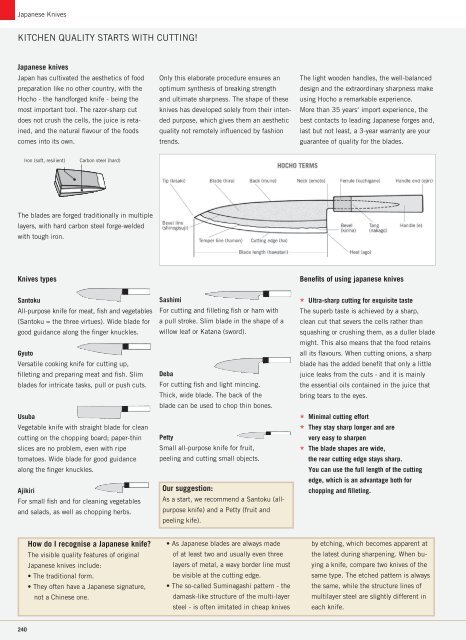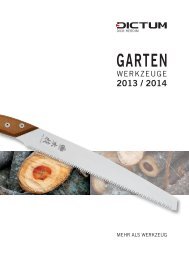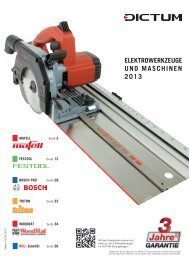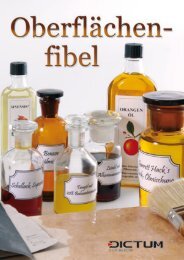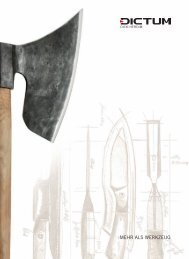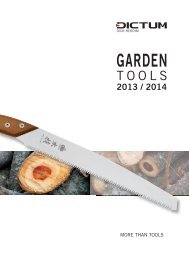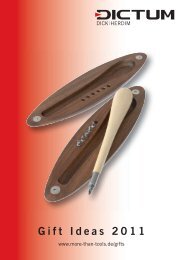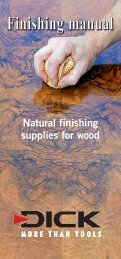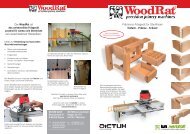- Page 4:
Our philosophy is basedon a very si
- Page 7 and 8:
Perfect results through clean cuts!
- Page 9:
SawsYOU CAN TRUST ON ITtooth checki
- Page 13 and 14:
SawsKataba SawsBecause of their thi
- Page 16 and 17:
SawsJapanese SawsaSatisfactionGuara
- Page 18 and 19:
SawsSheet Japanese Saws with interc
- Page 20:
Sawsdeluxe-SawsHand-made - for the
- Page 24:
Sawsaa ORIKOMI FOLDING SAW 250,COAR
- Page 27 and 28:
SawsaBa LIE-NIELSEN ® CROSSCUT SAW
- Page 29 and 30:
Sawsfreeway ®• Robust steel fram
- Page 31 and 32:
SawsBaa SaW gUide SetPrecision saw
- Page 33 and 34:
For perfect joints!Western Type | 3
- Page 35 and 36:
ChiselsSatisfactionchiselsDICK chis
- Page 37:
ChiselsJapanese TypeWherever absolu
- Page 41:
Chiselsaa HATTORI ® CARPENTER‘SC
- Page 44 and 45:
ChiselsTool Rolls and AccessoriesFo
- Page 46 and 47:
Sculpting ToolsSculpting Toolseurop
- Page 48 and 49:
Sculpting Toolspfeil carving toolsT
- Page 50 and 51:
Sculpting ToolsWOrKShOpCARVED BOxaa
- Page 52 and 53:
Sculpting Toolsaa PFEIL ALLONGEE GO
- Page 54 and 55:
Sculpting Toolspfeil compact carvin
- Page 58 and 59:
Sculpting Toolsnative americancarvi
- Page 60 and 61:
Sculpting Toolsa ARBORTECH TURBOPLA
- Page 62 and 63:
Sculpting Toolsa 152634Ba PFEIL WOO
- Page 64 and 65:
Sculpting Toolspfeil-Woodcutting to
- Page 66 and 67:
Sculpting ToolsSwedish typefrost ®
- Page 68 and 69:
SatisfactionSculpting ToolsSculptor
- Page 70 and 71:
Sculpting Toolsa B cdictUM satisfac
- Page 72 and 73:
Hatchets and Axesgränsfors Bruks
- Page 74 and 75:
Hatchets and Axesaxes and hatchetsw
- Page 76 and 77:
Hatchets and Axesaa WETTERLINGS ®S
- Page 78 and 79:
Hatchets and AxesJapanese axesWith
- Page 80:
Hatchets and Axesaxes»A blacksmith
- Page 83 and 84:
Lie-Nielsen ® Planes | 86Veritas
- Page 85 and 86:
Planes* »Bevel dOWn«advantageS an
- Page 87 and 88:
Planesa LIE-NIELSEN ®SHOULDER PLAN
- Page 89 and 90:
Planesaa LIE-NIELSEN ®SMOOTHING PL
- Page 91 and 92:
PlanesScraping planes• Scrape sur
- Page 93 and 94:
PlanesPlanesWe have developed our D
- Page 95 and 96:
PlanesKunz ® PlanesKunz is known f
- Page 97 and 98:
PlanesJapanese Planes (Kanna)Japane
- Page 100 and 101:
PlanesWestern Wooden Planese.c.e.
- Page 102 and 103:
PlanesScraper Blades and ScrapersSc
- Page 104 and 105:
Sharpening DevicesBench StonesKing
- Page 106 and 107:
Sharpening DevicesaBcShapton ®The
- Page 108 and 109:
Sheet Sharpening devicesGrita) Puri
- Page 110 and 111:
Sharpening Devicesnatural Japanese
- Page 112 and 113:
Sharpening DevicesaB c da DMT ® DI
- Page 114 and 115:
Sharpening DevicesSharpening Bestse
- Page 116 and 117:
Sharpening DevicesaB TORMEK ® DRIL
- Page 118 and 119:
Sharpening Devicesneed practical he
- Page 120 and 121:
Sharpening DevicesaBca OIL POT »AB
- Page 122 and 123:
Hammers, Nails, Pry BarsJapanese Ha
- Page 124 and 125:
Hammers, Nails, Pry Barswww.more-th
- Page 126 and 127:
Hammers, Nails, Pry Barsa B cdSoft-
- Page 128 and 129:
Hammers, Nails, Pry BarsJapanese na
- Page 130 and 131:
Woodturning ToolsWOODTURNING -A HAN
- Page 132 and 133:
Woodturning ToolsScrapersCROWN ® M
- Page 134 and 135:
Woodturning ToolsWiedemannWiedemann
- Page 136 and 137:
Woodturning Toolsaa HENRY TAYLOR ®
- Page 138 and 139:
Woodturning ToolsSharpening Devices
- Page 140 and 141:
Woodturning Toolsa 1 2 Ba AxMINSTER
- Page 142 and 143:
Woodturning ToolsPen-turning Access
- Page 144 and 145:
Rasps, FilesHand-Cut RaspsCut by ma
- Page 146 and 147:
Rasps, FilesB c daa hattOri ® raSp
- Page 148 and 149:
Rasps, FilesSuperhard file raspsRob
- Page 150 and 151:
Rasps, Filesa 1 2 3 4 5 6 7 8 B 1 2
- Page 152 and 153:
Rasps, Filesa F.D. ® CHECKERING FI
- Page 154 and 155:
Rasps, FilesHandles and Accessories
- Page 157 and 158:
Measuring and Inspection Instrument
- Page 159 and 160:
Measuring and Inspection Instrument
- Page 161:
Measuring and Inspection Instrument
- Page 164 and 165:
Measuring and Inspection Instrument
- Page 167 and 168:
Scribing andCutting ToolsExact scri
- Page 169 and 170:
Scribing and Cutting Toolsaa KUNz
- Page 171 and 172:
Router Bits | 172Wood Twist Drills
- Page 173 and 174:
Router Bits and Drilling ToolsWood
- Page 175 and 176:
Router Bits and Drilling ToolsaBa C
- Page 177 and 178:
Router Bits and Drilling Toolsa CRO
- Page 179 and 180:
Router Bits and Drilling ToolsBc 1a
- Page 181 and 182:
Screwdriversand PliersTrust them fo
- Page 183 and 184:
Screwdrivers and Pliersaa WERA ® K
- Page 185 and 186:
Screwdrivers and PliersPliersKeiba
- Page 187 and 188:
ClampsBinding together!Solid Steel
- Page 189 and 190: Clampsa ONE-HAND SPREADER CLAMPS ®
- Page 191 and 192: Clampsa PONY ® CLAMP FIxTURESLengt
- Page 193 and 194: Working with method!Tool Sets | 194
- Page 195 and 196: Workshop Accessories & Toolkitsa JA
- Page 197 and 198: Workshop Accessories & Toolkitsa UL
- Page 199 and 200: Workshop Accessories & Toolkitsaa I
- Page 201 and 202: Workshop Accessories & Toolkitsheue
- Page 203 and 204: Workshop Accessories & ToolkitscBc
- Page 205 and 206: Workshop Accessories & ToolkitsWool
- Page 207 and 208: Leder- und Papierwerkzeuge | Blindt
- Page 209 and 210: Leather- and Paper-Working Toolswww
- Page 211 and 212: Leather- and Paper-Working Toolslea
- Page 213 and 214: Bringing out the beauty of wood!Smo
- Page 215 and 216: FinishingMicro-Mesh ® abrasive and
- Page 217 and 218: FinishingSurface Protection and Col
- Page 219 and 220: FinishingBaa ASUSO ® NL BANGKIRAI,
- Page 221 and 222: FinishingaBa WOODEN PUTTY KNIFE FOR
- Page 223 and 224: FinishingGlues and Glue Potstitebon
- Page 225 and 226: FinishingSheet gluesno. / descripti
- Page 227 and 228: European Wood | 228A dream come tru
- Page 229 and 230: MaterialsExotic Wooda EBONYEbony, o
- Page 231 and 232: MaterialsNuts, Cones and Semifinish
- Page 233 and 234: Materialsa1a VULCANIzED FIBERVulcan
- Page 235 and 236: Materialsa1h2d1 2h DEER SKIN LACE,
- Page 237 and 238: MaterialsOther Animal Materialsaa B
- Page 239: The hocho is the soul of the cook«
- Page 243 and 244: Japanese Knivesa SHIGEFUSA HOCHO KA
- Page 245 and 246: Japanese KnivesHayashi HochoLight a
- Page 247 and 248: Japanese Knivesa TANGANRYU HOCHOA p
- Page 249 and 250: Japanese KnivesSaku hochoThese all-
- Page 251 and 252: Japanese KnivesInclusive free sharp
- Page 253 and 254: Japanese KnivesSharp, for all inten
- Page 256 and 257: Japanese Knivespuristical classicsK
- Page 258 and 259: Knives for Special ApplicationsKniv
- Page 260 and 261: Kitchen UtensilsKitchen UtensilsKni
- Page 262 and 263: Kitchen Utensilspeeler, rasps and a
- Page 264 and 265: Kitchen Utensilstea Bowls, tea Boxe
- Page 266 and 267: Kitchen Utensilscast-iron cookwarea
- Page 268 and 269: Hunting and Outdoor KnivesSaji‘s
- Page 270 and 271: Hunting and Outdoor KnivesJapanese
- Page 272 and 273: Hunting and Outdoor Knivesnordic hu
- Page 274 and 275: Hunting and Outdoor KnivesJapanese
- Page 276 and 277: Hunting and Outdoor KnivesWestern d
- Page 278 and 279: Hunting and Outdoor KnivesartO fold
- Page 280 and 281: Hunting and Outdoor Knivesa MASERIN
- Page 282 and 283: Blades and Blade Blanksa SWEDISH DA
- Page 284 and 285: Knife KitsaBa IC CUT ® OUTDOOR KNI
- Page 286 and 287: Razors and ScissorsTHE FINE ART OF
- Page 288 and 289: Razors and ScissorsaBa RAzOR WITHGO
- Page 290 and 291:
Razors and ScissorsKlarHigh-quality
- Page 292 and 293:
Razors and ScissorsJapanese tailor
- Page 294 and 295:
Garden ToolsHoes and Clawstwo-hande
- Page 296 and 297:
Garden ToolsShovels, Forks and Rake
- Page 298 and 299:
Garden ToolsOne-Hand Garden ShearsJ
- Page 300 and 301:
Garden Toolslöwe ® prunersThe inv
- Page 302 and 303:
Garden ToolsBall valve ofcentre oil
- Page 304 and 305:
Garden Toolsaa HAND-FORGED HEDGEAND
- Page 306 and 307:
Garden Toolsaa BARNEL ® DOUBLE-EDG
- Page 308 and 309:
Garden Toolsaa JapaneSe teleScOpicp
- Page 310 and 311:
Garden ToolsaBca SCYTHE SICKLEThis
- Page 312 and 313:
Garden Toolsaa CONCAVE BRANCH CUTTE
- Page 314 and 315:
Garden Toolsa JAPANESE RUBBER BOOTS
- Page 316 and 317:
Arts and CraftsWooden ObjectsUrushi
- Page 318 and 319:
Arts and CraftsBamboo productsBambo
- Page 320 and 321:
Arts and Craftsaa LEIHO STOOLA uniq
- Page 322 and 323:
Arts and Craftsaa »INDEN-YA« POCK
- Page 324 and 325:
BooksThe more intensively one studi
- Page 326 and 327:
BooksPRACTICAL DESGINThis book offe
- Page 328 and 329:
BooksBANDSäGEN - EINRICHTEN,BEHERR
- Page 330 and 331:
BooksTHE ART OF HANDSEWING LEATHERA
- Page 332 and 333:
indexIndexaAbrasive and polishing c
- Page 334 and 335:
indexHook tool (woodturning) 134Hor
- Page 336 and 337:
indexSickle hoe 294, 309Sickle knif
- Page 338 and 339:
MORE THAN JUST One TOOL CATALOGUEal
- Page 340:
Order Hotline:Telephone: +49-(0)991


